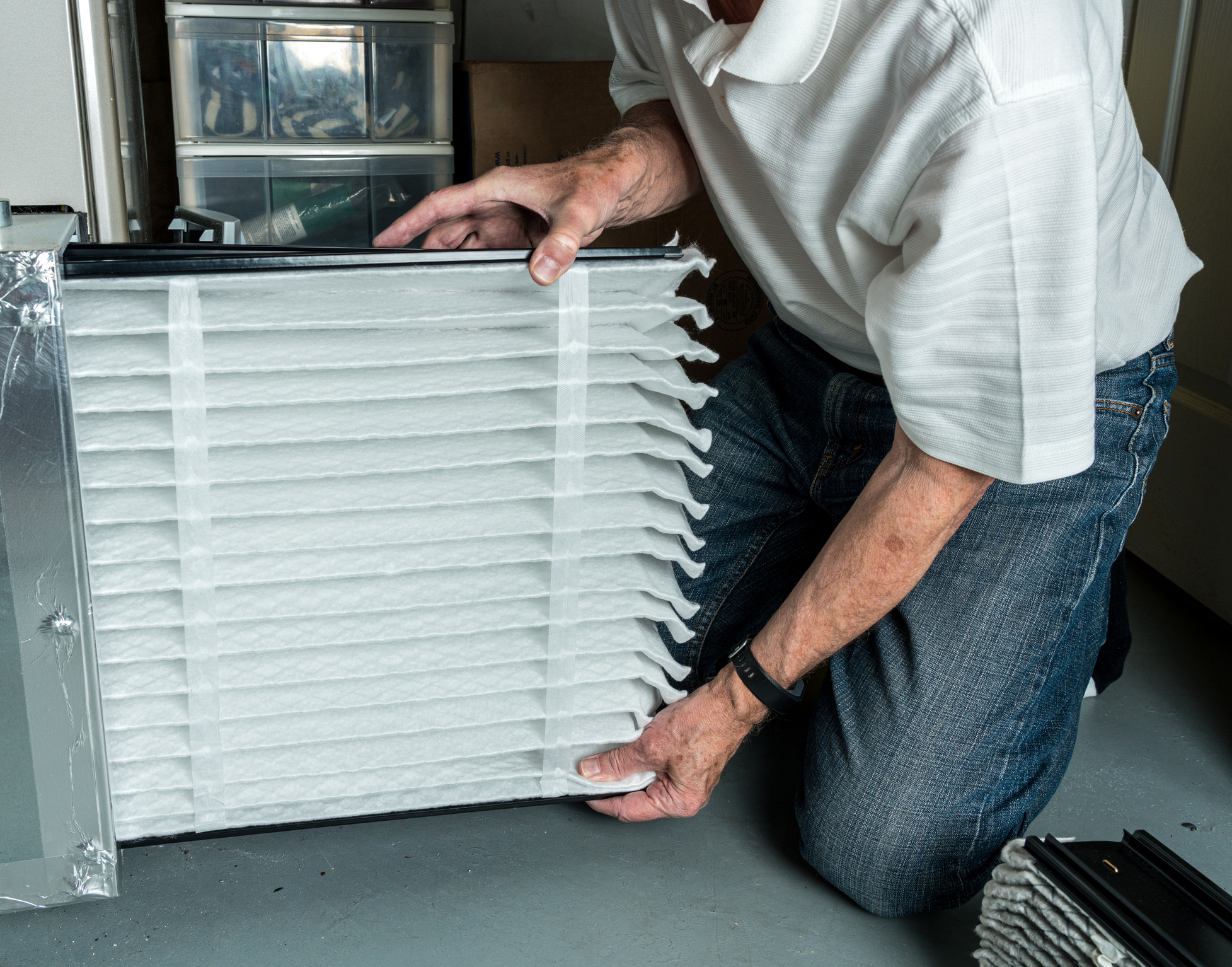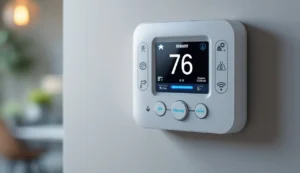
A bedroom dehumidifier can transform your sleep quality by pulling excess moisture from the air. Studies show that keeping bedroom humidity between 45-50% creates the perfect environment for deep, restful sleep. Here’s something wild: Your body releases nearly 1 pint of moisture into your bedroom air just through breathing and sweating each night. Have you ever woken up feeling sticky and tired? Switching to a dehumidifier could improve your indoor air’s quality and your sleep! Here are the key ways a bedroom dehumidifier can boost your sleep quality, protect your bedroom furniture, and help you save money while doing it.
How to Check Your Bedroom’s Humidity
Ever wake up feeling sticky and uncomfortable? Your bedroom’s moisture level might be the sneaky culprit behind those restless nights. Think about it – you breathe out water vapor all night long. Your plants release moisture. Even your morning coffee’s steam adds to the mix. All this moisture has to go somewhere!
Getting to know your bedroom’s moisture level is super simple. You can:
- Grab a digital humidity meter (they’re cheap!)
- Look for condensation on windows
- Notice if your clothes feel damp
- Watch for that musty smell
The sweet spot? Keep your bedroom’s humidity levels between 30-50%. Any higher, and you’re basically inviting dust mites to a party!
Common Moisture Sources
Your bedroom collects moisture from places you might not expect:
- Hot showers in connected bathrooms
- Indoor plants (they’re cute but sweaty!)
- Wet towels hanging to dry
- Your breath while sleeping
- Outside air sneaking through windows
- Drying laundry in your room
Summer brings humid air through windows, while winter heating can trap moisture inside. Not dealing with high humidity isn’t just about comfort – it hits your wallet too! Excess moisture makes your AC work harder and can damage wooden furniture. Plus, those foul odors and mold spores aren’t doing your health any favors. Check your walls and windows in the morning. If they’re wet with condensation, it’s time to take action!
How Humidity Affects Your Sleep
Your body is pretty smart about keeping cool while you sleep. But when your room is too humid, it can’t do its job right. Think of it like trying to cool down with a fan in a steamy bathroom – it just doesn’t work well.
REM sleep (that’s when you dream) gets hit the hardest. Studies show that high humidity levels can cut your deep sleep time by up to 30%. That’s why you might feel like a zombie in the morning!
The Perfect Sleep Zone
Want to know the sweet spot? Keep your bedroom’s humidity level between 30-50%. This helps you fall asleep faster, stay asleep longer, wake up feeling fresh (not groggy!). A good bedroom dehumidifier can be your best friend here. It’s like having a sleep guardian that keeps the air just right while you catch those Z’s.
Think of humidity control as giving your bedroom a comfort upgrade. Just like you wouldn’t sleep well on a rock-hard mattress, you shouldn’t have to deal with sticky, humid air either!
Pro tip: Get a dehumidifier with a digital humidity display. It takes the guesswork out of keeping your sleep space perfect. Plus, many new models are whisper-quiet, so they won’t disturb your beauty sleep.
The Hidden Economics of Bedroom Dehumidification
Want to know something cool? Running a bedroom dehumidifier actually saves you money in the long run:
- Your AC works less hard (hello, lower energy bills!)
- Your furniture lasts longer (no warped wood or rusty metal)
- You’ll spend less on allergy medicine
- Your walls and paint stay fresh longer
The best part? Most modern dehumidifiers use less electricity than a light bulb. That’s about $5-10 monthly to protect thousands in bedroom furniture.
But money isn’t everything. Better air quality means: – Easier breathing at night – Less coughing and sneezing – Fewer allergy symptoms – No musty smells
Think of a dehumidifier as insurance for your sleep space. It’s working 24/7 to keep your bedroom feeling fresh and your furniture looking new.
P.S. Those breathing problems you blame on seasonal allergies? They might just be from high humidity. A dehumidifier could be your simple fix.
How Humidity Affects Your Body
Nasal Comfort and Sleep Quality
Your nose is like a natural air filter. When your bedroom has too much moisture, it can make your nasal passages feel stuffed up or uncomfortable. This is where a dehumidifier becomes your best friend.
A dehumidifier helps by: – Making it easier to breathe through your nose – Reducing that sticky, heavy feeling in the air – Helping prevent dust mites that love humid spaces – Creating the perfect breathing environment for sleep
Better Breathing, Less Snoring
Want to know something cool? The right humidity level (between 30-50%) can actually help reduce snoring. How? By keeping your air passages clear and comfortable.
When you breathe better, you: – Fall asleep faster – Stay asleep longer – Wake up feeling more refreshed – Have fewer midnight wake-ups
Your body naturally follows certain breathing patterns during sleep. But when the air is too humid, it’s like trying to breathe through a wet blanket. Improved air quality doesn’t just help you sleep – it helps you wake up feeling better too. No more morning stuffiness or that heavy-headed feeling.
Where to Place Your Dehumidifier
The spot where you put your dehumidifier can make or break how well it works in your bedroom. Just plugging it in anywhere won’t cut it. You need a game plan.
Let’s start with the basics. Your dehumidifier should be about 6-10 feet away from your bed. This distance is perfect because it’s close enough to control moisture near your sleeping area but it’s far enough that any noise won’t bug you while you sleep. You also want to place your dehumidifier away from walls and furniture. This helps it pull in air better and keeps your room’s air quality top-notch.
Airflow and Noise Management
Your dehumidifier needs room to breathe. Keep it: – Away from walls (at least 6 inches) – Clear of curtains or furniture – Near problem areas (like windows that get condensation) – Off the floor if possible (a small table works great)
Want your dehumidifier to be super quiet? Try these tricks: – Put a rubber mat underneath to stop vibrations – Face the back toward a wall to muffle sound – Check for loose parts that might rattle – Pick a spot on a flat, stable surface
Coverage Zone Tips
Your bedroom size matters big time. Here’s how to nail the coverage: – Small rooms (up to 150 sq ft): Place it in a corner – Medium rooms (150-300 sq ft): Center it along the longest wall – Large rooms (300+ sq ft): Consider two smaller units instead of one big one
Pro tip: Keep your dehumidifier away from your AC unit or heating vents. They’ll just fight each other, and that’s no good for your energy bill!
Remember: The goal is to help you breathe easier and sleep better. If you notice any spots still feeling damp after a few days, just move your unit to a new spot until you find that sweet spot.
Tips for Optimal Dehumidifier Usage
Smart Timer Settings for Better Sleep
Set your dehumidifier to run about an hour before bedtime. This gives it time to create the perfect sleeping environment. Most modern dehumidifiers let you pick a target humidity level – aim for 45-50% while you sleep. Want to save money on your power bill? Use the energy-efficient mode at night. It works like cruise control for your dehumidifier, running only when needed.
Worried about noise? Pick the “sleep mode” or “quiet operation” setting. These settings keep the noise down to a soft hum.
The Seasonal Adjustment Guide
Your dehumidifier needs different settings as the weather changes:
- Winter: Keep humidity at 40-45% and run it less often (cold air is naturally drier)
- Summer: Bump humidity up to 45-50% and run more frequently. Check the filter every 2 weeks
Integrate a Dehumidifier With Sleep-Enhancement Tools
When you pair your dehumidifier with an air purifier, you’re hitting air quality issues from two angles. The dehumidifier tackles moisture while the air purifier catches those pesky dust mites and allergens. Hook these up to your HVAC system, and you’ve got a powerful trio. Your AC won’t have to work as hard in summer, and you’ll save on those energy costs.
Want to take it up a notch? Smart home automation lets you control everything from your phone. Set your ideal humidity levels before bedtime, and let your devices do the work while you drift off to dreamland.
Adjust your Room’s Humidity Level As Needed
Think of your bedroom as your sleep sanctuary. Everyone’s different, and that’s why customization matters:
- Track your sleep patterns with a smart device
- Adjust settings based on your health conditions
- Set different modes for summer and winter
- Monitor room temperature and humidity together
Remember to check your comfort level each morning and tweak as needed. Your perfect sleep setup might take a few nights to dial in, but your body will thank you!
Transform Your Sleep Quality With Dehumidifiers from Dowd
Better sleep isn’t just about having a comfy mattress – it’s about creating the right environment. I’ve seen hundreds of Montgomery County homeowners transform their sleep by adding a simple bedroom dehumidifier to their nightly routine.
Ready to wake up feeling refreshed? Our team at Dowd HVAC can help you pick the perfect dehumidifier for your bedroom. Take the first step toward better sleep by scheduling your consultation online today. Your perfect night’s sleep is just a click away at our website.





